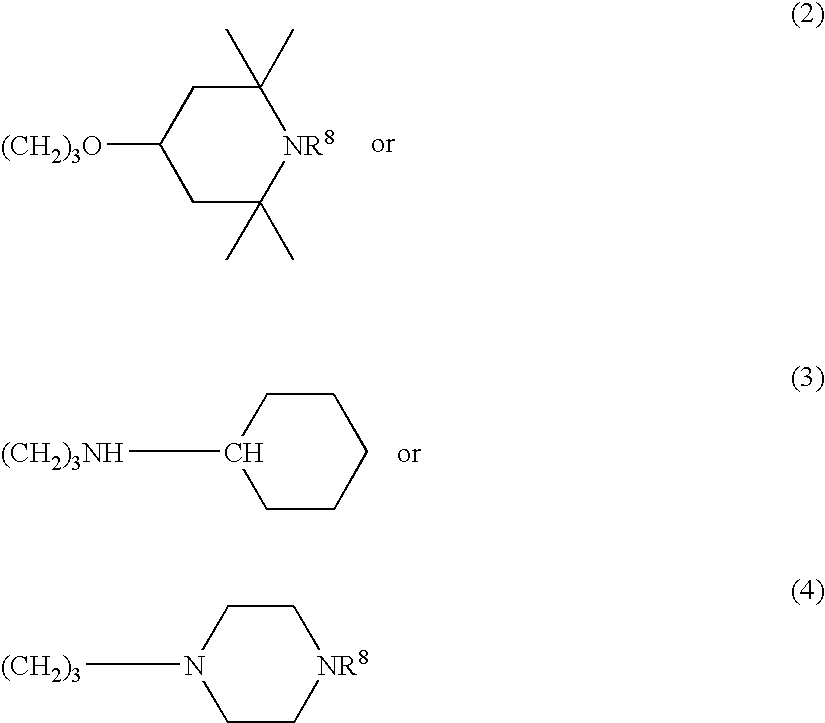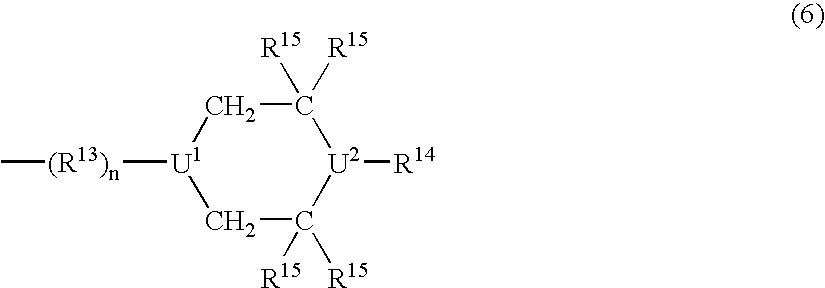Fabric softener compositions
a technology of compositions and softeners, applied in the preparation of detergent mixture compositions, detergent powders/flakes/sheets, detergent compounding agents, etc., can solve the problems of accumulation of build-up through wash cycles, wrinkle recovery treatment, adverse effects of wet soiling, etc., to achieve softening and condition fabrics, and effective imparting fabric softness
- Summary
- Abstract
- Description
- Claims
- Application Information
AI Technical Summary
Benefits of technology
Problems solved by technology
Method used
Image
Examples
example 2
Reduction of Micro Creases on Cotton (Prior to Ironing)
[0382]The formulated rinse conditioners (see Table 1) are applied according to the following procedure:
[0383]Woven cotton swatches of size of 50 cm by 40 cm are washed together with ballast material (cotton and cotton / polyester) in a AEG Oeko Lavamat 73729 washing machine maintaining the washing temperature at 40° C. The total fabric load of 1 kg is washed for 15 minutes with 33 g of ECE Color Fastness Test Detergent 77 (Formulation January 1977, according to ISO 105-CO6). The rinse conditioner formulation as described in Table 1 is applied in the last rinse cycle at 20° C. After rinsing with the formulation the textile swatches are dried on a washing line at ambient temperature.
Evaluation of Micro Creases
[0384]The creasing (surface smoothness) of the dried swatches is evaluated according to the MTCC-Standard method Nr. 124. Five persons evaluate the creases of the cotton swatches against the MTCC THREE DIMENSIONAL Smoothness Ap...
example 3
Reduction of Micro Creases on Cotton (After Ironing)
[0387]The textile swatches (cotton woven) from Example 2 are divided in 2 parts and one of it (with a size of 20 cm to 40 cm) is slightly rewetted with 6.5 ml water (fine sprayed over the textile surface) and ironed without pressure for 60 seconds at 160° C.
[0388]The micro creases of the ironed swatches are evaluated according MTCC-Standard method Nr. 124 as described in Example 2.
[0389]
TABLE 3(Results of the evaluation of creaseson cotton by AATCC method after ironing)Sample of rinse conditionerformulationAATCC evaluationReference3.5A4.8B4.0C5.0D4.0E4.0F4.0G4.4H4.5I4.0J4.0K4.0L4.5M4.5O4.5P4.5Q4.5R4.0S4.0
[0390]These results show that microcreases can be removed significantly better by ironing when the textile fabric material is treated with compositions of the present invention.
example 4
Reduction of Micro Creases on Cotton / Polyester (Prior to Ironing)
[0391]The formulated rinse conditioners (see Table 1) are applied according to the following procedure:
[0392]Woven cotton / polyester swatches of size of 50 cm by 40 cm are washed and rinsed according to procedure described in Example 2.
Evaluation of Micro Creases
[0393]The creasing (surface smoothness) of the dried swatches is evaluated according to procedure described in Example 2.
[0394]
TABLE 4(Results of the evaluation of creases oncotton / polyester by AATCC method prior to ironing)Sample of rinse conditionerformulationAATCC evaluationReference2.6A2.7B3.0C2.9D2.6E2.9F2.9G3.1H2.8I2.8J2.8K3.0L2.8M2.9N2.9O2.9P2.5Q2.5R3.2S2.8
[0395]The above results show a marked improvement in surface smoothness for the textile fabric material treated with compositions of the present invention.
PUM
| Property | Measurement | Unit |
|---|---|---|
| temperature | aaaaa | aaaaa |
| temperatures | aaaaa | aaaaa |
| diameter | aaaaa | aaaaa |
Abstract
Description
Claims
Application Information
 Login to View More
Login to View More - R&D
- Intellectual Property
- Life Sciences
- Materials
- Tech Scout
- Unparalleled Data Quality
- Higher Quality Content
- 60% Fewer Hallucinations
Browse by: Latest US Patents, China's latest patents, Technical Efficacy Thesaurus, Application Domain, Technology Topic, Popular Technical Reports.
© 2025 PatSnap. All rights reserved.Legal|Privacy policy|Modern Slavery Act Transparency Statement|Sitemap|About US| Contact US: help@patsnap.com



